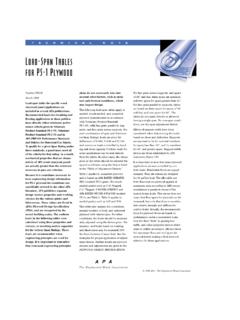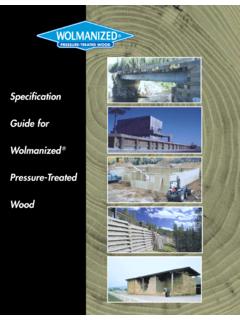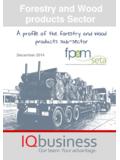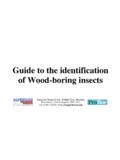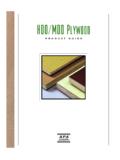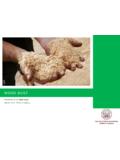Transcription of Wood poles have historically been the mainstay of the of ...
1 Outside Plant Consulting Services, Inc. P S C A Comparison of Wood and Distribution poles of Other Materials Relative to the Rules of the National Electrical Safety Code (NESC) or Why is a Grade C Metal pole Required to be Stronger than a Grade B Metal pole ? Prepared by: Outside Plant Consulting Services, Inc. October 18, 2002 for Powertrusion International, Inc. OUTSIDE PLANT CONSULTING SERVICES, INC. AND POWERTRUSION INTERNATIONAL, INC. - PROPRIETARY This document and the proprietary information it contains shall be distributed, routed, or made available solely to authorized persons within Powertrusion International, except with written permission of OPCS or Powertrusion. 2 About Outside Plant Consulting Services, Inc. (OPCS) Outside Plant Consulting Services, Inc.
2 (OPCS) was established in the year 2002 to help meet the needs of the telecommunications and power industries in establishing standards, guidelines and practices for outside plant facilities and products. The OPCS Group provides related support services for field deployment, and product evaluation and analysis. Dr. Lawrence (Larry) M. Slavin, Principal of OPCS, has extensive experience and expertise in such activities, based upon his many years of service at AT&T/Lucent Bell Telephone Laboratories (Distinguished Member of Technical Staff) in telecommunications product design and development, followed by a career at Telcordia Technologies (Bellcore) in its research and professional service organizations.
3 As Principal Consultant and Manager/Director of the Network Facilities, Components, and Energy Group at Telcordia, Dr. Slavin was responsible for professional services related to the telecommunications industry. These activities include technical leadership in developing installation practices and generic requirements documents, introducing new construction methods, and performing analyses on a wide variety of technologies and products ( poles , electronic equipment cabinets, flywheel energy storage systems, turbine-generators, ..). Throughout his long career, he has had a leading role in the evolution of many telecommunications related fields and disciplines -- including aerial and buried plant design and reliability; advanced construction and cable placement techniques; copper pair, coaxial, and fiber-optic technology; flywheel energy storage systems; physical design and development of hardware and electronic and electro-optic systems ( SLC 96 digital loop carrier.)
4 ; cable media and equipment reliability studies; exploratory fiber-optic hardware development; and systems engineering. Dr. Slavin is a member of several subcommittees of the National Electrical Safety Code Committee (NESC), responsible for specifying safety standards for aerial and buried telecommunications and power facilities in the United States. He is also an active member and participant on the Accredited Standards Committee ASC-O5 ( ANSI-O5 ) for wood poles and products. Dr. Slavin is a Charter Member of the North American Society for Trenchless Technology, has been instrumental in the development of directional drilling standards, and participates in training and certification activities for the directional drilling industry.
5 Technical contact: Dr. Lawrence M. Slavin Outside Plant Consulting Services, Inc. 15 Lenape Avenue Rockaway , NJ 07866 Phone: 1-973-983-0813 FAX: 1-973-983-0813 E-Mail: OUTSIDE PLANT CONSULTING SERVICES, INC. AND POWERTRUSION INTERNATIONAL, INC. - PROPRIETARY See restrictions on front page. 10/18/02 3 Table of Contents Table of 1. 2. Wood pole 3. NESC Strength NESC Overload 4 OUTSIDE PLANT CONSULTING SERVICES, INC. AND POWERTRUSION INTERNATIONAL, INC. - PROPRIETARY See restrictions on front page. 10/18/02 4 Abstract Although wood poles continue to be the primary choice for constructing power and telecommunications distribution lines, there are many applications for which alternate pole materials, typically engineered products (steel, concrete, fiber-reinforced composite,), represent an optimum solution.
6 However, it is important to maintain the structural reliability of the non-wood poles relative to the existing wood poles , based upon the rules of the National Electrical Safety Code (NESC). The NESC strength and loading rules are specified as a function of grade of construction (reliability level), which will determine the appropriate size (strength) pole to withstand wind and ice storms, to meet the basic safety requirements. The different grades of construction will require a different capacity or strength. Since the utilities have experience and familiarity with the wood pole classification system ( pole class ), it is convenient for steel, concrete, .. poles to be classified similarly, to facilitate their selection and use by the utility.
7 However, due to the inherently different characteristics (statistical distributions, ..) of naturally grown wood and engineered pole structures, the equivalency of a given non-wood pole size/strength ( pole class number) for a Grade B construction application will, in general, not be the same for a Grade C construction application. The present article attempts to clarify such issues, based upon the NESC strength reduction and overload factors. As explained herein, an engineered pole that is equivalent to a Class 4 wood pole (2400 lbs. average strength) for a Grade B application is required to have a minimum strength of 1560 lbs. In order to be equivalent to a Class 4 wood pole for a Grade C application, the engineered pole must have a significantly greater minimum strength of 2040 lbs.
8 If the lower strength (1560 lbs.) Grade B equivalent pole , is used for a Grade C application ( , longer span length, more attachments,..), then the storm loading will result in a greater load (2040 lbs.) than it would be able to withstand to any appreciable degree. In this case, although the large majority of Class 4 wood poles would survive, the large majority of the non-wood, Grade B equivalent Class 4 poles would fail. OUTSIDE PLANT CONSULTING SERVICES, INC. AND POWERTRUSION INTERNATIONAL, INC. - PROPRIETARY See restrictions on front page. 10/18/02 51. Introduction Wood poles have historically been the mainstay of the utility distribution plant, for both power and telecommunications. Such poles have served well and provided reliable, economic service in the past, and will likely continue to be widely used in the future.
9 Nonetheless, there are many applications for which alternate pole materials, typically engineered products (steel, concrete, fiber-reinforced composite, ..), represent an optimum solution. Depending upon the specific alternate material, the advantages of such materials, include: Environmental (no chemical preservatives) Light weight ( , rear lot and other difficult access situations) Longevity (not vulnerable to water or insects) Appearance (colors, shapes, ..) However, it is important to maintain the structural reliability of the alternative non-wood poles relative to the existing wood poles . The National Electrical Safety Code has served to provide basic safety rules to ensure such reliability.
10 Unfortunately, these rules are sometimes confusing to the general industry and public, and therefore not always properly understood or correctly interpreted when attempting to introduce the non-wood alternatives. The purpose of this article is to clarify these rules and their application, including to a non-technical audience. The 2002 Edition of the National Electrical Safety Code (NESC), ANSI C2[1], provides basic safety requirements for the installation, operation or maintenance of outdoor communication and electric power facilities. It therefore complements the National Electrical Code (NEC) which provides requirements for indoor facilities. The NESC is intended to primarily focus on helping ensure the safety of employees and the public, and is not intended to be a design specification or instruction manual.

